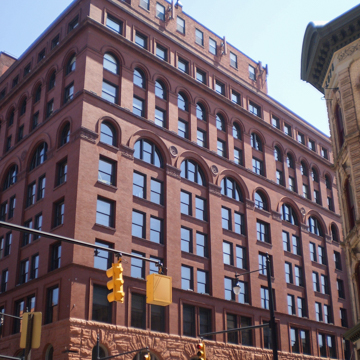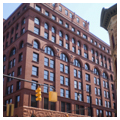You are here
Trust Building (Michigan Trust Company Building)
This early office skyscraper marked Grand Rapids as the financial center of outstate Michigan. Anton G. Hodenpyl, Lewis H. Withey, Willard Barnhart, Darwin D. Cody, and other Grand Rapids and western Michigan businessmen organized the Michigan Trust Company in 1889 and built the bank and office building two years later. The building is a major Michigan work of Chicago architect Beman. It resembles his Pioneer Press Building of 1888–1889 in St. Paul, Minnesota. The Richardsonian Romanesque building rises in four stages to a flat roof, its windows decreasing in size within their round-arched groupings as they progress upward from the huge round-arched openings of the rusticated coursed sandstone base. To protect against fire, the steel and iron frame is sheathed with fire tiles, floors are constructed of hollow tile and concrete, and exterior walls are clad in red sandstone, brick, and terra-cotta. Historian Leonard K. Eaton (in correspondence with the author) has discovered that “it [the Trust Building] is one of several buildings across the country which are variants on Root's Rookery (Chicago, 1884).” In 1913 two ten-story sections were added to the rear, and in the 1920s, the eleventh floor was added.
Writing Credits
If SAH Archipedia has been useful to you, please consider supporting it.
SAH Archipedia tells the story of the United States through its buildings, landscapes, and cities. This freely available resource empowers the public with authoritative knowledge that deepens their understanding and appreciation of the built environment. But the Society of Architectural Historians, which created SAH Archipedia with University of Virginia Press, needs your support to maintain the high-caliber research, writing, photography, cartography, editing, design, and programming that make SAH Archipedia a trusted online resource available to all who value the history of place, heritage tourism, and learning.


















